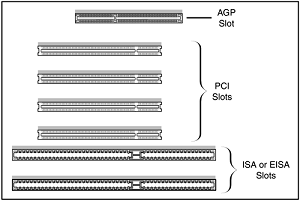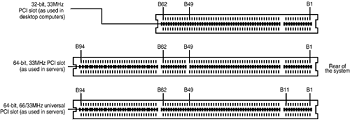PCI Bus
In early 1992, Intel spearheaded the creation of another industry group. It was formed with the same goals as the VESA group in relation to the PC bus. Recognizing the need to overcome weaknesses in the ISA and EISA buses, the PCI Special Interest Group was formed.
The PCI bus specification was released in June 1992 as version 1.0 and since then has undergone several upgrades. PCI redesigned the traditional PC bus by inserting another bus between the CPU and the native I/O bus by means of bridges. Rather than tap directly into the processor bus, with its delicate electrical timing (as was done in the VL-Bus), a new set of controller chips was developed to extend the bus.
The PCI bus often is called a mezzanine bus because it adds another layer to the traditional bus configuration. PCI bypasses the standard I/O bus; it uses the system bus to increase the bus clock speed and take full advantage of the CPU's data path.
Systems that integrate the PCI bus became available in mid-1993 and have since become a mainstay in the PC. Information typically is transferred across the PCI bus at 33MHz and 32 bits at a time. The bandwidth is 133MBps, as the following formula shows:
33.33MHz x 4 bytes (32 bits) = 133MBps
Currently, the 64-bit or 66MHz and 133MHz variations are used only on server- or workstation-type boards and systems. Aiding performance is the fact that the PCI bus can operate concurrently with the processor bus; it does not supplant it.
The CPU can be processing data in an external cache while the PCI bus is busy transferring information between other parts of the system—a major design benefit of the PCI bus.
A PCI adapter card uses its own unique connector. This connector can be identified within a computer system because it typically is offset from the normal ISA, MCA, or EISA connectors found in older motherboards. See Figure 1 for an example.

The size of a PCI card can be the same as that of the cards used in the system's normal I/O bus. The PCI specification identifies three board configurations, each designed for a specific type of system with specific power requirements; each specification has a 32-bit version and a longer 64-bit version.
The 5V specification is for stationary computer systems (using PCI 2.2 or earlier versions), the 3.3V specification is for portable systems (also supported by PCI 2.3), and the universal specification is for motherboards and cards that work in either type of system.
64-bit versions of the 5V and universal PCI slots are found primarily on server motherboards. The PCI-X 2.0 specifications for 266 and 533 versions support 3.3V and 1.5V signaling; this corresponds to PCI version 2.3, which supports 3.3V signaling.
Figure 2 compares the 32-bit and 64-bit versions of the standard 5V PCI slot to a 64-bit universal PCI slot. Figure 3 shows how the connector on a 64-bit universal PCI card compares to the 64-bit universal PCI slot.


Notice that the universal PCI board specifications effectively combine the 5V and 3.3V specifications. For pins for which the voltage is different, the universal specification labels the pin V I/O. This type of pin represents a special power pin for defining and driving the PCI signaling rail.
Another important feature of PCI is the fact that it was the model for the Intel PnP specification. Therefore, PCI cards do not have jumpers and switches and are instead configured through software.
True PnP systems are capable of automatically configuring the adapters, whereas non-PnP systems with ISA slots must configure the adapters through a program that is usually a part of the system CMOS configuration. Starting in late 1995, most PC-compatible systems have included a PnP BIOS that allows the automatic PnP configuration.